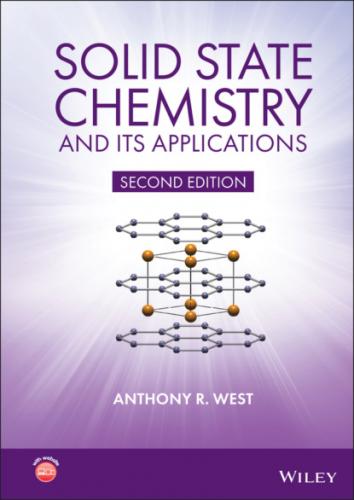In Fig. 1.53(c, d), the trigonal point group, 3 is shown. This has a threefold axis perpendicular to the plane of the stereographic projection (d) and is represented by the solid triangle. Three equivalent positions are generated by the operation steps that involve rotation by 120°, either clockwise or anticlockwise, as shown in (c). Point groups 4 and 6 use the same principles as described for point groups 2 and 3 and are illustrated in Appendix E.
Figure 1.53 The point groups (a, b) 2, (c, d) 3, and (e–h) m.
Figure 1.54 The point groups (a)
Monoclinic point group m is shown in Fig. 1.53(e, f) and in another orientation in (g, h). This has a single mirror plane which lies in the plane of the projection in (f) and is represented as a thick circle. Equivalent positions are generated by reflection across the mirror plane and hence, our starting position 1, above the plane generates an equivalent position 2, represented by an open circle, directly underneath the plane (e). In (h) the same point group, m, is shown but oriented vertically and perpendicular to the plane of the circle. It is represented by the thick line that bisects the projection that is shown; in this orientation, the equivalent positions are either side of the mirror and both are shown above the plane, (g); equally, they could both be below the plane.
The centre of symmetry in the point group,
The inversion axes, spoken as: bar n , i.e.
So far, we have considered point groups that have a single symmetry element. The three orthorhombic point groups shown in Fig. 1.55 all have combinations of symmetry elements. For each, again, two diagrams are used. First, point group 222 has the three, mutually perpendicular twofold axes shown in (b): one is perpendicular to the plane of the projection, passes through the centre and is represented by the lens‐shaped symbol in the centre of the projection; one runs vertically in the plane of the projection and is represented by two symbols on the circumference of the circle at the top and bottom; one runs horizontally in the plane of the projection and is represented by the two symbols at the left and right on the circle circumference.
In order to generate equivalent positions in point group 222, it is necessary to first, identify a starting position, shown in Fig. 1.56(a), and operate on that position with one of the symmetry elements, for example the 2‐fold axis perpendicular to the plane of the projection. This generates a new equivalent position shown in (b). The operation is then repeated until arriving back at the starting position. The next step, 2 is to consider the effect of the symmetry operations associated with one of the other symmetry elements, which generates an additional set of equivalent positions. This is shown in (c) for the 2‐fold axis running horizontally and in the plane of the paper; each of the equivalent positions in (b), above the plane of the projection, generates a new position below the plane. Finally, the effect of the third symmetry element, step 3 is considered.
Figure 1.55 The three orthorhombic point groups 222, mm2, and mmm.
In this case, however, no new equivalent positions are generated in (d). The third 2‐fold axis, shown vertically in the plane of the paper, is essentially redundant since it arises automatically from the presence of the other 2‐fold axes. The point group 222 could therefore be represented in the shortest possible notation as 22 because the third twofold axis is not independent. The longer notation is used in order to show consistency with the essential symmetry requirements (Table 1.1) for orthorhombic unit cells. The order in which the symmetry axes are considered in Fig. 1.56 is unimportant and any two of the 2‐fold axes together generate the third axis automatically.
Orthorhombic point group mm2, Fig. 1.55 contains two mirror planes at right angles to each other with a 2‐fold axis passing along the line of intersection of the mirror planes (d). The 2‐fold axis is perpendicular to the paper and the mirror planes are indicated in projection as the thick lines lying horizontally and vertically. This point group also has four equivalent positions, but all are at the same height relative to the plane of the paper (c). As in the previous example, the third symmetry element
